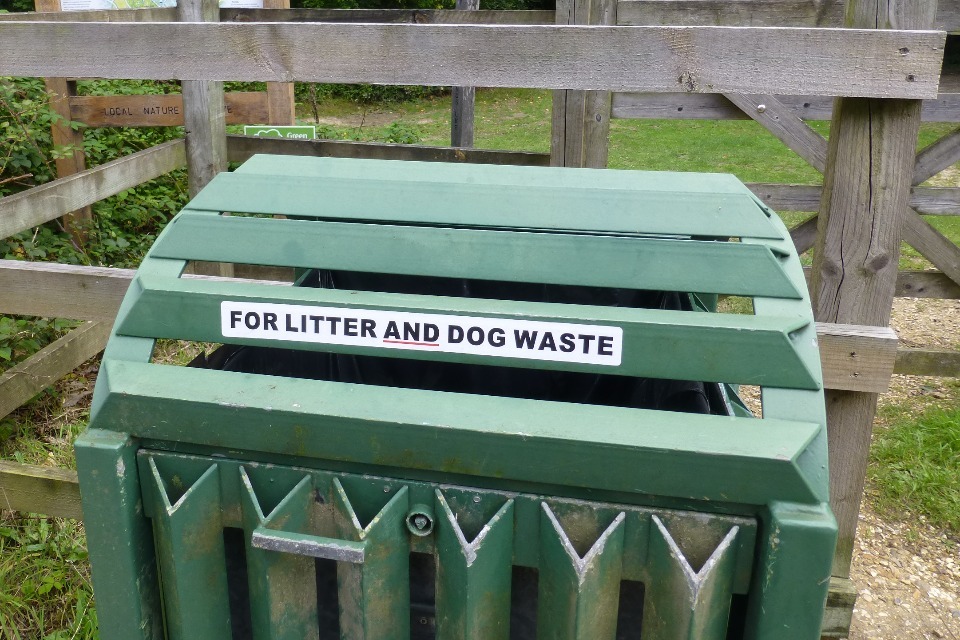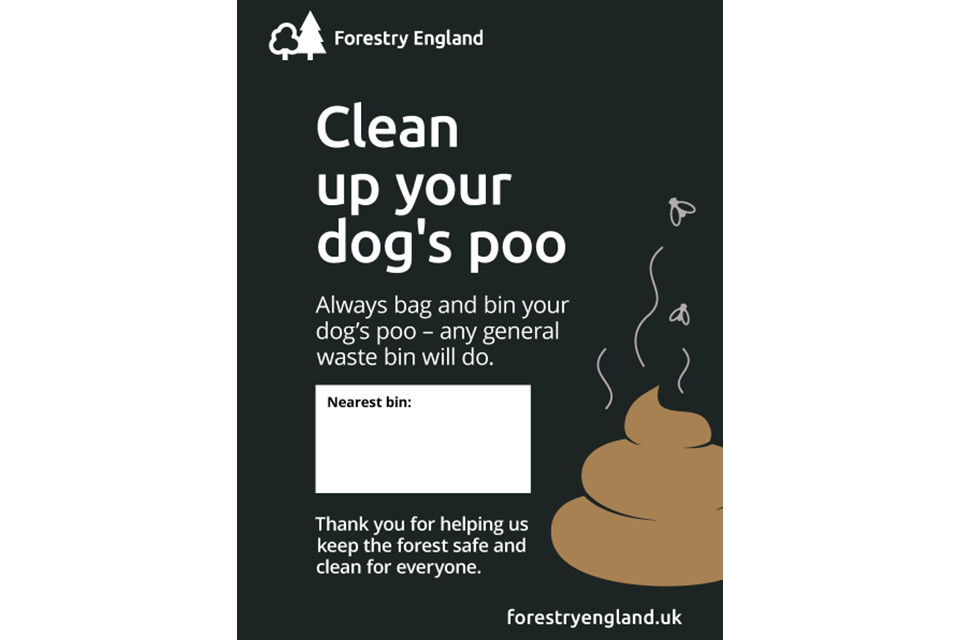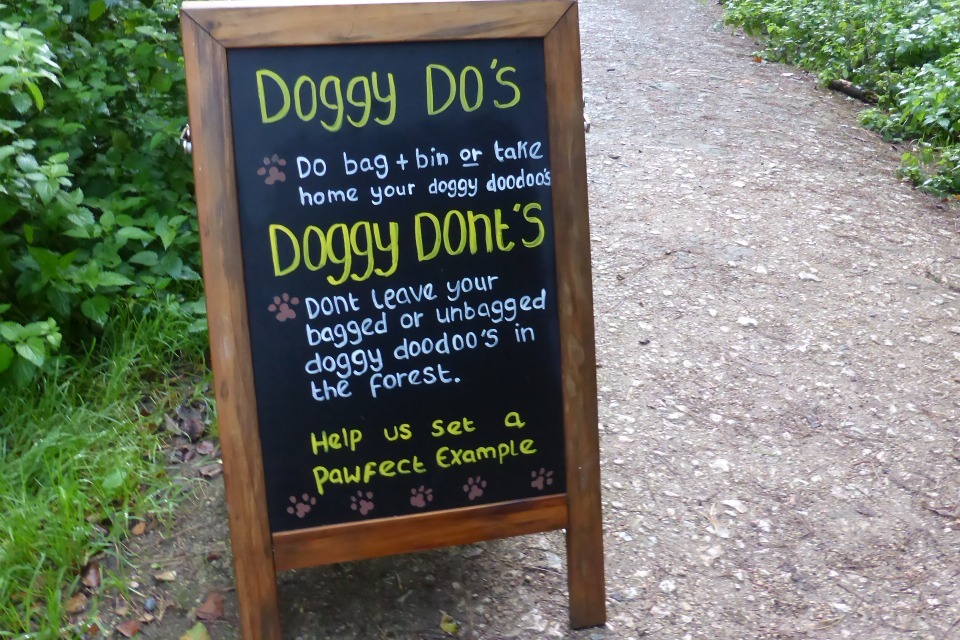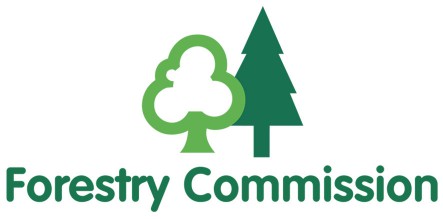Managing dog fouling in your woodland
Published 16 January 2025
Applies to England
Dog fouling is a problem for both woodland owners and visitors, including those with dogs. Good management and clear explanations are essential for addressing the issue.
Management options for dog fouling
Managing dog fouling can improve woodlands and create safe, welcoming environments.
Ideally, visitors will take bagged dog waste home. However, research shows that visitors with dogs are less likely to pick up their dog’s waste in rural areas compared to urban or formal landscapes. Providing clear signage about what to do with waste and, in some cases, bins can help to reduce fouling.
If there is existing access to your woodland, involve dog walkers in developing solutions. Chat to them about why some people don’t pick up or leave filled bags behind, they may give useful insights and become good role models for other dog walkers.
Before taking action, carry out an inspection and record:
- how clearly fouling rules are communicated at each access point
- hot spots for fouling or bags left behind
- location, condition and management of bins, signage and information
Decide how best to manage dog fouling in your woodland with these options.
Signage
Check if the local council’s dog warden and access teams, or existing campaigns such as Keep Britain Tidy, have materials that can help.
Be clear about what you want people to do. Use signage at all access points and along paths. If your dog fouling policy applies to the entire woodland, clearly state this.
Here are some examples of wording:
- ‘Never leave your dogs’ poo anywhere in the woodland, even in a bag. It can cause illness in people, livestock and wildlife.’
- ‘Any public waste bin will do for bagged dog poo.’
- ‘When there are no bins, please use your bin at home. Deodorised bags and containers can make bags of dog poo easier to carry.’
Check online (especially local dog walking pages) and local information for public-facing information about your woodland: make sure it’s clear about your dog waste policy.

Example sign showing ‘clean up after your dog’ and take the waste home. Copyright Steve Jenkinson.
Bins
Providing bins can help reduce dog fouling and the amount of bagged dog waste being left behind by dog walkers.
Bagged dog waste can be put in general litter bins, or there is the option to have separate dog waste bins in your woodland. Separate bins may increase the costs of emptying and can undermine Countryside Code messages that any bin will do for bagged dog waste.

A bins shows dog waste can be mixed with general litter with the sign 'for litter and dog waste. Copyright Steve Jenkinson.
Top tips on bins:
- place bins in car parks and where dogs are most likely to foul, which is usually a few hundred metres from entry/access points
- have a ‘Thank you for using this bin.’ message on the bins
- make it clear on every general litter bin that bagged dog waste can be disposed of there
- if able, provide poo bags in dispensers by bins
-
add signs showing where bins are in located in your woodland, such as:
- ‘Bins suitable for dog poo can be found at these locations…’
- ‘There’s another bin 500 metres ahead on this path.’
Wooden cladding or screening can be used to improve the appearance of bins.

A poster by Forestry England states 'clean up your dog's poo' with a blank space for adding locations for nearest bins. Crown Copyright.
Dog waste disposal
The issue with dog waste is not the waste itself, but how it is handled. When managing disposal, consider the following:
- compare different contractors to find the best price
- ensure contractors will service bins within the woodland, not just in car parks
- mixing bagged dog waste with general litter can simplify transport and contain spills
- be wary of contractors who claim dog waste is hazardous and charge extra for separate disposal
- bins may be used more during school or bank holiday weekends, check that contractors will collect the waste during these times
Some woodland grant schemes may cover the cost of installing bins, but typically do not fund ongoing maintenance.
Stick and flick
Previously, asking visitors to flick dog waste away from paths was encouraged. This was seen as a pragmatic way to reduce the number of bags left behind and avoid providing bins.
This method is less popular now due to worries about nutrient enrichment in sensitive habitats and possible risk of spreading disease. You can still apply the ‘flick it off the path’ approach in certain areas, but clearly mark these boundaries to prevent confusion about where the policy applies in the woodland.
Ongoing management options
Once the basics have been implemented, you may also want to consider other ways of managing fouling.
Community-based ‘Green Dog Walker’ schemes
‘Green Dog Walker’ schemes are community-based campaigns where dog walkers sign a pledge to participate. Such schemes have been successful in reducing fouling and can:
- raise awareness and support wider issues, such as protecting sensitive wildlife and grazing livestock
- encourage reporting of issues such as fires and antisocial behaviour
- provide a more effective approach than relying on signage alone, making it worth the resources to set up and maintain
Your local authority may already have a scheme you can embrace. Search ‘Green Dog Walkers’ online for examples.
Free waste bags
Some sites offer free bags in dispensers to encourage people to pick up after their dogs.
Bags can even be printed with your messages. Compostable corn starch bags are preferred over plastic. Avoid labelling them as ‘biodegradable’ to prevent visitors from thinking they can leave them in the woodland.
Local canine services, like vets, pet shops, or commercial dog walkers, can sponsor bins or bags to help reduce costs.
Stopping free bag distribution may lead to increased dog fouling if visitors have become used to having them.
Painting poo
Using chalk-based marker paint to spray on or around dog poo will vividly demonstrate the problem. Be clear that this is a temporary effect for long-term benefit.
Spraying indicates active management is in place and may deter offenders.
Using a different colour each week can show if behaviours are changing and aid monitoring.
Raise awareness by sharing what you are doing on-site and online. This can pre-empt any complaints that it spoils a natural landscape.
Highlight other woodland activities
Dog walkers may not realise that off-path activities, such as forest school and orienteering, take place. Adults and children could be affected by dog waste left behind.
If routes are used by equestrians, explain that horse dung does not cause the same problems as dog waste. Otherwise, horse dung may be mistakenly seen as a justification for leaving dog waste behind.
Highlight environmental concerns
Make visitors aware of the negative impact dog waste has on the environment by explaining that:
- it’s not just about the inconvenience of people stepping in dog waste
- dog waste and bags can kill sheep, cows and wildlife
- dog waste can reduce wildflower and insect numbers
- horse and livestock dung does not cause the same problems for wildlife due to a meat-free diet
- dogs should be wormed regularly for their own health, and to reduce the spread of diseases to people, cattle and other animals
Temporary signs
You can temporarily target a hot spot using A-boards, for example. This demonstrates that the issue is being monitored closely. A-boards are often more effective than laminated paper signs.
Frequently moving signs around can make them more effective, as visitors can become ‘sign-blind’.

An example handwritten a-board sign showing 'doggy do's and doggy don'ts'. Copyright Steve Jenkinson.
Displaced poo
These actions could lead to fouling being displaced to less well-observed areas. While not ideal, moving fouling away from the most sensitive locations may be a pragmatic outcome, compared to trying to eliminate fouling everywhere.
Monitoring and maintenance
Consider doing repeated counts of fouling and bags left along the same section of path to track changes over time. It is good practice to share this information with visitors using temporary signs or social media, so you can thank them for a reduction in fouling, or to highlight an increase.
If problems persist after clearly communicating what you want, consider the following measures:
- place bins where there’s a concentration of dog waste or relocate existing bins to hot spot areas
- chat to dog walkers, who may be able to offer insights as to why the measures are not effective
- if signs are not working, ask dog walkers for their feedback: you may need to re-word them or place them elsewhere
- are there too many signs? Overloading information may lead to important messages being lost
- using a variety of interventions over time can be highly effective, as visitors are most likely to notice changes
The law on dog fouling
There is no nationwide law on dog fouling in England. Read more about legal options and good practice: dealing with irresponsible dog ownership.
Good management is generally more effective than a legal approach. However, your local authority may be able to introduce Public Spaces Protection Orders (PSPOs) to designated areas where people can be issued with a Fixed Penalty Notice for leaving dog waste behind.
Local authorities can also issue Community Protection Notices (CPNs) to persistent offenders, which can prevent them from visiting specific areas like woodlands. Read more on PSPOs and CPNs.
Further resources on dogs in woodland
Read more about managing visitors with dogs in your woodland.

